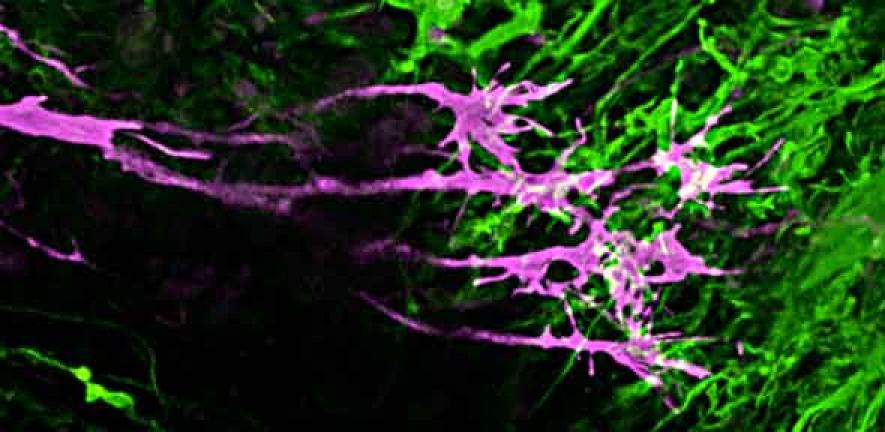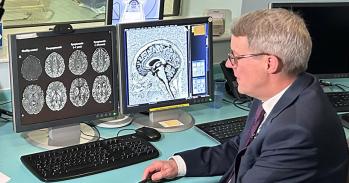
Today, we commence a month-long focus on neuroscience. To begin, Ed Bullmore, Bill Harris and Dervila Glynn describe how this area of research is transforming our understanding of the healthy brain and promising new treatments for devastating disorders that affect millions of people.
Today, we commence a month-long focus on neuroscience. To begin, Ed Bullmore, Bill Harris and Dervila Glynn describe how this area of research is transforming our understanding of the healthy brain and promising new treatments for devastating disorders that affect millions of people.
The human brain with its approximately 10 billion neurons making 10 trillion synapses is clearly the most complex puzzle on the planet, and there are a myriad of ways it can go wrong or deteriorate.
The brain is an organ of extraordinary complexity. At a genetic level, over half of our genes are dedicated to the brain – building it and keeping it functional over a lifetime. At a cognitive level, the brain controls the ways we react to every situation and how the consequences of these reactions, according to reward or punishment, shape us as individuals.
To understand these things at a mechanistic level is a huge challenge – one that transcends biology. It increasingly involves novel alliances with mathematicians, physical scientists, computational scientists, psychologists and philosophers, and yields intellectual capital that stretches from pharmacology, psychiatry and philosophy through to education, engineering, ethics and economics.
When it became clear nearly ten years ago that neuroscience was growing at an extraordinarily fast rate and across a huge range of disciplinary lines, the University set up Cambridge Neuroscience (see panel). Today this Strategic Research Initiative consists of over 700 researchers in more than 60 different departments across the University of Cambridge and its local institutes.
However, despite the incredible advances in science and technology that we have witnessed over the past century, we have not yet seen them translated into benefits for tackling brain disease in the same way as has been the case for cancer. The human brain with its approximately 10 billion neurons making 10 trillion synapses is clearly the most complex puzzle on the planet, and there are a myriad of ways it can go wrong or deteriorate. Translational research – which promises to translate the fundamental advances of neuroscience to progress in the understanding and treatment of brain and mental health disorders – has therefore become the cornerstone of Cambridge Neuroscience.
Dementia is one area where there is an urgent need to capitalise on the innovative research taking place and translate discoveries into effective treatments. In February 2015, the Prime Minister set out the government’s latest phase of its national programme to tackle one of the biggest global health and social care challenges, stating that it aims for England to be “the best place in the world” to undertake research into dementia and other neurodegenerative diseases.
To this end, Alzheimer’s Research UK (ARUK) announced Europe’s first Drug Discovery Institutes (DDIs) for neurodegenerative diseases that cause dementia in late 2013. This ambitious initiative is a network of three DDIs, based at the Universities of Cambridge and Oxford and University College London. The ARUK Cambridge DDI will build collaborations between Cambridge researchers, developing drug discovery projects based on the world-leading research carried out at the University. Led by drug discovery experts working in partnership with many of the UK’s academic leaders in this area, the alliance aims to attract 90 scientists across the three DDIs, all focused on neurodegenerative diseases. It now forms one of the largest and most coordinated efforts to find new drugs for dementia.
Cambridge Neuroscience also has a formidable track record when it comes to breaking down the barriers between science and business. A three-year collaboration between AstraZeneca, MedImmune and Cambridge Neuroscience, agreed in 2014, with a total value of approximately $6 million focuses on advancing research and development in neurodegenerative diseases. Scientists from all three parties are collectively addressing gaps in drug discovery, translational biomarkers and personalised healthcare approaches for diseases such as Alzheimer’s disease, Parkinson’s disease and multiple sclerosis. This type of strategic partnership promotes an increased understanding of disease mechanisms and enables work in basic neuroscience to address unmet therapeutic needs in a variety of serious neurodegenerative diseases.
Another recent example of Cambridge Neuroscience working innovatively in partnership with industry and other universities is a Wellcome Trust Strategic Award for Neuroimmunology of Mood Disorders and Alzheimer’s Disease. This major consortium, led from Cambridge, brings together Janssen, GSK, Lundbeck and Pfizer, as well as academics from Oxford, King’s College London, Southampton, Cardiff, Glasgow and Sussex, to explore the novel idea that immunological and inflammatory mechanisms may contribute to depression and dementia. One potential advantage of this strategy is that many anti-inflammatory drugs have already been developed for disorders like rheumatoid arthritis. So, if the consortium can discover the specific immune mechanisms implicated in these neuropsychiatric disorders, there is an opportunity to “repurpose” existing medicines to deliver therapeutic impact more rapidly than the 15–20 year timeline of a more conventional drug development project.
In 2014, Cambridge received a number of prestigious awards from the Medical Research Council totalling up to £28 million, which have provided funding for a new ultra-high field 7T magnetic resonance imaging (MRI) system, a new combined positron emission tomography (PET)/MRI system, an upgraded 3T MRI system, and expanded and enhanced radiochemistry facilities, as well as equipment for high-performance computing to handle the large quantities of data generated by the new scanners. Funding from the University will additionally support procurement of a new 9.4T MRI system for animal neuroimaging. This will help us develop new ways of classifying and simulating brain disease in animals, leading to better diagnosis and more effective drug discovery in humans.
Looking to the future, our aim is for these significant advances in imaging technology and expertise to help bring together basic and clinical neuroscientists with a focus on understanding and treatment of mental health symptoms in a proposed Centre for the Translational Neuroscience of Mental Health.
In September 2016, Cambridge Neuroscience will graduate from being a Strategic Research Initiative to become one of the University’s first Interdisciplinary Research Centres, demonstrating the University’s commitment to maintaining Cambridge’s position as a world class leader in multi-disciplinary neuroscience research.
Our aim is to maintain high standards of creativity and innovation in our approach to studying the brain in order to meet some of the greatest scientific challenges of the 21st century: understanding how brains are organised and grow, how they function normally to produce thoughts and feelings, how they can be affected by disease to cause neurological and mental health symptoms and, ultimately, how we can find better treatments for Alzheimer’s disease, schizophrenia, autism and many other disabling disorders of brain and mind.
Neuroscience and brain research will be celebrated in a public festival planned for 16–18 September 2016 in Cambridge. For more details, see www.neuroscience.cam.ac.uk/events
Professor Ed Bullmore and Professor Bill Harris are Co-Chairs and Dr Dervila Glynn is the Coordinator of Cambridge Neuroscience.
Benchmark analysis of neuroscience in Cambridge
Cambridge Neuroscience was formed in 2007, and in 2010 became one of the University’s first Strategic Research Initiatives.
In 2014, RAND Europe was commissioned to conduct an independent bibliometric analysis of 700+ researchers to assess the strength of the neuroscience community, and found that research by individuals currently affiliated with Cambridge Neuroscience has consistently had a substantially higher citation impact than the world average (approximately double).
The researchers have approximately 2.5 times more articles than expected in the top 10% most highly cited publications. When compared with 49 other leading institutions in the UK publishing in the area of neuroscience, Cambridge has the highest citation impact for overall research portfolio, as well as the highest percentage of Highly Cited Publications. Nearly half the publications involve at least one national collaborator, and just over half involve at least one international collaborator.
RAND EUROPE reported: “The findings suggest that research performance has continuously been high, and substantially above world averages. The benchmarking results clearly indicate that Cambridge Neuroscience has reinforced its position as one of the leading institutions in the UK working in the area of neuroscience.”
RAND also found that since the establishment of Cambridge Neuroscience, the collaboration rate and interconnectedness of neuroscience research both locally within Cambridge and between Cambridge neuroscientists and the international scientific community increased measurably.

The text in this work is licensed under a Creative Commons Attribution 4.0 International License. For image use please see separate credits above.




